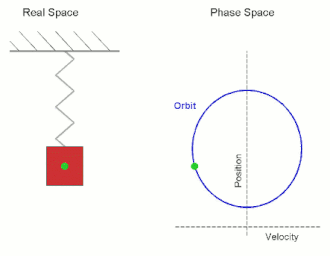
Back حركة توافقية بسيطة Arabic Гарманічныя ваганні Byelorussian সরল স্পন্দন গতি Bengali/Bangla Moviment harmònic simple Catalan Mudiant harmonig syml Welsh Simpel harmonisk bevægelse Danish Απλή αρμονική ταλάντωση Greek Movimiento armónico simple Spanish Lihtharmooniline võnkumine Estonian Higidura harmoniko sinple Basque

| Part of a series on |
| Classical mechanics |
|---|
In mechanics and physics, simple harmonic motion (sometimes abbreviated as SHM) is a special type of periodic motion an object experiences by means of a restoring force whose magnitude is directly proportional to the distance of the object from an equilibrium position and acts towards the equilibrium position. It results in an oscillation that is described by a sinusoid which continues indefinitely (if uninhibited by friction or any other dissipation of energy).[1]
Simple harmonic motion can serve as a mathematical model for a variety of motions, but is typified by the oscillation of a mass on a spring when it is subject to the linear elastic restoring force given by Hooke's law. The motion is sinusoidal in time and demonstrates a single resonant frequency. Other phenomena can be modeled by simple harmonic motion, including the motion of a simple pendulum, although for it to be an accurate model, the net force on the object at the end of the pendulum must be proportional to the displacement (and even so, it is only a good approximation when the angle of the swing is small; see small-angle approximation). Simple harmonic motion can also be used to model molecular vibration.
Simple harmonic motion provides a basis for the characterization of more complicated periodic motion through the techniques of Fourier analysis.
- ^ "Simple harmonic motion | Formula, Examples, & Facts | Britannica". www.britannica.com. 2024-09-30. Retrieved 2024-10-11.
